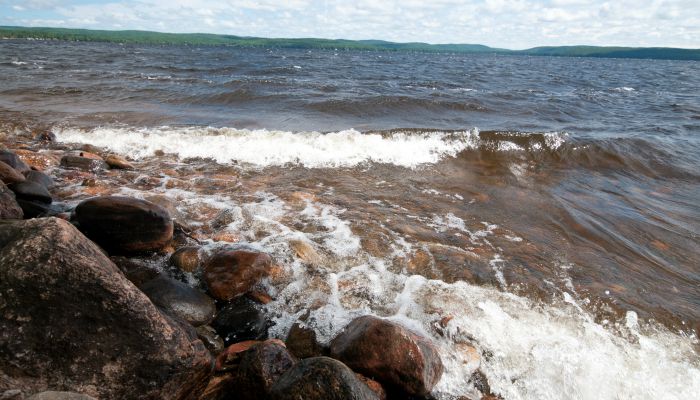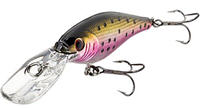
Take me to a walleye lake I’ve never fished before and I’m a happy angler. It’s always fun to solve the “where are the ‘eyes” puzzle. Here are 3 fundamentals I rely on when looking for ‘eyes in new water.
1. Locate High Walleye Percentage Areas

GPS Plotter
You can’t catch walleye if you can’t find them. Studying a lake’s layout is a first step. Do your homework by looking at digital contour maps and Google Earth. Then tour the lake upon arrival, reading the landscape and using marine sonar. Here’s what to look for:
- Inflowing tributaries create current in lakes. From spring to fall, the mouth of a tributary and the surrounding water attracts walleye.
- Rocky points and sand bars often hold fish. They act as highways for walleye moving from deep resting areas to shallow, feeding spots.
- Humps are classic walleye structure. In the North Country lakes I fish, humps topping out in depths from 20 to 35 feet are best in summer and fall.
- Islands and reefs appeal to walleye. When hit with waves, the shallow to mid-depth portions of these structures deliver good action.
- Sand and mud flats hold yellow perch and aquatic invertebrates, which are food for walleye.
- Healthy vegetation used by minnow and perch populations will draw walleye. Isolated clumps, large deep beds, and the outside edge of large weed flats are three prime areas.
2. Fish the Conditions - Walleye Don't Follow a Rule Book
After locating potential spots, decide where and how to fish based on the time of day and conditions. Walleye don’t follow a rule book, but consider these trends:
- Dawn and dusk are prime feeding times as walleye see well in low light. This is most pronounced in clear water. Shallow to mid-depth shorelines, weed beds, points, flats, and reefs are common twilight and night restaurants.
- Overcast skies diffuse light, stimulating walleye activity. I catch them at various depths when it’s cloudy. The secret is locating an area with plenty of forage. Find the food, find the walleye.
- Waves disrupt the water’s surface, diffusing light and encouraging feeding; hence, the term “walleye chop”. Fish the wave-hit side of structure, shorelines and weed beds.
- Calm, sunny days can be challenging. Focus on deep structure. Walleye will also hold in shade under plants.

3. Use Reliable Fishing Tactics
The following are 4 core walleye presentations. I rely heavily on them when exploring new water. Beginners should focus on mastering these before trying out other tactics.

Trolling Crankbaits
Trolling covers water and it’s a reliable way to catch walleye. Use shallow to moderate diving lures like a Berkley Flicker Shad or Rapala Shad Rap over the deep weeds, along rocky shorelines, and all around reefs. These baits are also excellent for casting these areas.

Use deep-diving baits when walleye are farther down in the water column. Running a Rapala Deep Tail Dancer, Storm ThunderStick, or Reef Runner 800 on 100-plus-feet of line will catch walleye from deep bars, humps, and flats.
Spinner Rigs
A walleye spinner rig is deadly for summertime ‘eyes. Tip it with a live-bait like a nightcrawler, minnow or leech. Use a 1/8- to 1/4-ounce bullet sinker in front of the rig’s swivel for trolling shallow or around weeds. To work deeper water nearby, use a bottom bouncer sinker for dragging the rig over sand and rocky humps, bars and flats.

Jigging
Jigging is a dependable walleye method. Slowly lifting and touching the floor with a minnow like Yo-Zuri Crystal Minnow Deep Diver Walleye Series or worm on a jig catches walleye from bottom. Using a snap-jigging or swimming retrieve with a grub, minnow or fluke fools active walleye prowling shorelines, drop-offs, sand flats, humps and reefs. Jigs can also be pitched to deep vegetation to entice big fish.
The Lindy Rig
A Lindy minnow rig, is good for fussy walleye. The walking sinker helps it crawl over snags and stay on the bottom. Tip the hook with a live minnow, worm, or leech. Drift with the rig over humps, bars, and flats with one finger on the line. When you feel a bite, release the line and let the fish take the bait for 5 to 10 seconds. Then close the bail, reel in slack, and set the hook.

The next time you’re out fishing for walleye try these tips for a great day on the lake.
Want to learn more? See these links:
Walleye trolling gear by Keith Kavajecz
Bottom-bouncing by Keith Kavajecz
Vertical jigging by Keith Kavajecz
Lindy Rigging Video From Pros4-1Source and Jon Thelen
- 39854 views


